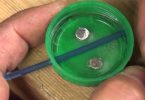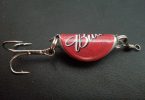What is KHV?
KHV is an abbreviation for Koi
Herpes Virus. KHV is highly infectious and since
1998 has spread rapidly in to countries on at least four continents. During
2006 it was found on 23 fisheries in the
It causes very high mortalities among diseased
populations of carp (Cyprius carpio) of any variety – common, ghost or
Koi, but not any other species. (more background information is available on
pages 3 and 4).
KHV became a notifiable disease in
to report it to the authorities when its presence on a site is suspected or
confirmed.
It is probably wise to assume any
site in the world producing carp might be infected unless they can provide
evidence that they are not.
What are the
signs OF KHV I WILL SEE?
KHV should be considered as a
potential culprit (not the culprit) if:
Ø
Only Carp (Cyprinus carpio) including koi,
ghosts and common varieties are affected and killed. If other species such as goldfish and grass
carp in the same system remain unaffected even if diseased carp are present,
then the presence of KHV may be suspected.
Ø
Mortalities occur at water temperatures between 15o
and 28o C. If during an
outbreak the temperature rises above or falls below this range mortalities may
diminish or stop.
Ø
Mortalities are very rapid. Seemingly healthy fish become ill and die in
24-48 hours.
Ø
Very severe mortalities 80-100% mortalities occur
within 10 days of disease outbreak.
Ø
Bleeding from the gills (that may also release virus
and part account for its’ infectious nature).
Ø
White patches, (where excess mucus has been produced
or tissue has died) which may be small to very extensive, on the gills or skin.
Ø
Sunken eyes.
Ø
Occasionally fish have shown signs of nervous
problems (that is periods of inactivity followed by hyperactive behaviour
triggered by a very small stimulant).
The Koi Herpes Virus can suppress a fishes immune
system. The body can’t then react as it
would normally to prevent infections. Thus
secondary invasions on bacteria and parasites might be the most obvious problem
on an individual fish, but these signs may obscure the damage caused by the
virus.
None of these visual
techniques can identify KHV directly but they give very strong indications of
its presence. Laboratory tests are used
to confirm the presence of KHV (more details page 4).
Can We protect ourselves?
Make sure your suppliers know about KHV
Ensure that your suppliers are
aware of KHV – send them this document.
Ensure that they liase with their government to make sure that they meet
any testing requirements placed on them.
No Koi or other carp should be
accepted from any unknown source, including retail customers and returned to
your holding systems.
Selection of Source of Fish
If the source of your fish hasn’t
been infected with KHV then the fish you buy cannot carry the virus. The following criteria and questions might be
helpful in formulating enquiries to suppliers:
Ø
Has the site ever been tested for KHV? If so when and what were the results? By whom were the samples selected and
collected? Which laboratory undertook
the tests using which method – PCR, ELISA,
microscopy etc.
Ø
Has the site a protected (fish free) water source
such as a well or borehole? Are barriers
in place to prevent fish swimming upstream into the site? Does the site flood? What precautions are in
place to prevent birds entering the site or dropping live fish into pools on
the site?
Ø
Have the fish been mixed with stock from any other
source in the supply chain? This is a particularly pertinent question to ask of
exporters or importers who consolidate stock from either a wide geographic area
or a number of production units. The
more stages there are in the supply chain, the more potential for cross
contamination if mixing occurs.
Ø
Have any fish been brought onto the suppliers site
recently? If so from where, and what
measures were taken at those sites to demonstrate freedom from KHV.
Preventative Acclimatisation
An acclimatisation period may be
used to try to determine if the fish are carrying KHV.
Each batch of fish brought on to a
site must be isolated, this is a normal requirement of any good husbandry or
stock system. If you require exporters to give assurances as part of the contract
of supply, they may require that you provide evidence of an effective isolation
policy of new stocks and its effective practical application. Basic records of water quality, mortalities
and observations of fish stocks should be maintained and held for reference.
To prevent latent infection
remaining undiscovered at some point in the supply chain fish may be subject to
a period of “preventative acclimatisation/isolation†of at least 14 days,
ideally longer at 23-28 degree C. Any
batch of fish in which signs of illness or disease and particularly showing
mortalities similar to what this report has called the “calling card†of KHV
should be subject to PCR tests. If these
prove positive, then that source of supply may be considered unsuitable until
adequate remedial action has been undertaken.
Batches from sources of supply
might usefully be screened prior to the start of the next coldwater
season. To be confident of the results
of such screening, the isolation policy must be absolute. Given the apparent infectious nature of the
virus in closed systems no chances of cross contamination should be tolerated
if the test results are to be useful.
All water should be discharged via
the foul sewerage system.
Size and Frequency of Import Consignments
The risk of losses may be reduced by importing smaller
consignments more frequently than perhaps has been custom in the past. However this may require more investment in
isolation facilities.
SURVIVORS
Survivors of an outbreak of KHV should be regarded as carriers
of the virus.
DISINFECTION
UV inactivates KHV as does a temperature of 50oC
maintained for 1 minute. At 15oC
the following are reported in scientific papers as effective:
|
Disinfectant |
Concentration |
Time of |
|
Iodophore (found in agricultural disinfectants) |
200 |
30 |
|
Benzalkonium chloride |
60 |
30 |
|
Sodium hypochlorite (often found in domestic |
200 |
30 |
|
30% Ethyl alcohol |
|
30 |
BACKGROUND
INFORMATION ON KHV
Where did KHV come from?
The origin of KHV is unknown. It was first recognised as causing a
significant problem at an Israeli ornamental fish farm in the Spring of
1998. However advanced techniques have
shown that it was responsible for an outbreak of disease in
time being a mystery.
Have
Herpes Viruses including KHV any special Characteristics that I should Know
about?
In many instances once an animal
is infected with a herpes virus, it is infected for life. Herpes Infections are generally characterised
as being
Ø
Chronic
Ø
Latent
Ø
Recurrent
KHV is able to remain latent in
infected fish for months or years.
Disease is only caused when the environmental conditions, in particular
temperature, are at an optimum for virus development.
How dOEs KHV spread?
KHV appears to be able to survive
only for a short time outside the carp it is infecting. The key means of movement is therefore likely
to be the carp themselves.
Water, nets, equipment, personnel
and other species of fish might transfer the virus but are not as efficient at
doing so as live carp. Even so the risk
of transmission by these routes should not be ignored.
WHere is KHV found now?
|
|
|
|
|
|
|
|
|
|
|
No occurrences in |
|
|
|
|
|
|
|
|
|
|
|
|
|
|
|
|
|
|
|
|
The |
|
|
|
|
|
|
|
|
|
|
|
|
|
|
|
|
|
* in fish imported from
Laboratory Techniques OF DETECTING KHV
The damage caused by KHV can be
detected by using high powered light microscopes and highly specialised
electron microscopes.
The tests most widely used to
detect KHV are:
Ø
PCR – Polymerases Chain Reaction
tests: which identify the presence of virus or the remains of dead virus.
Ø
ELISA – Enzyme Linked Immuno-Sorbant
Assay – this test identifies the presence of chemicals known as antibodies
which the fishes body produces in response to infection with KHV.
Neither of these laboratory tests
is able to accurately determine the presence of
latent virus. Both tests are able
to confirm the presence of KHV when symptoms of the disease are present or
mortalities have occurred.
Evidence from as many as possible
of the methods discussed above should be used when deciding if a site is either
infected with or free from KHV.
Where can I get more information?
On the OATA members login
area. Details from the OATA office,
01373 301302, info@ornamentalfish.org








